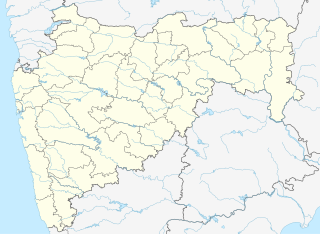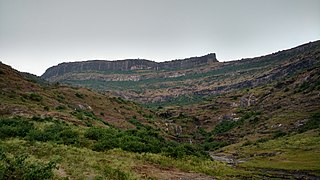
Panhala is a city and a Hill station Municipal Council 18 km northwest of Kolhapur, in Kolhapur district in the Indian state of Maharashtra. Panhala is the smallest city in Maharashtra and being a Municipal Council the city is developing rapidly. The city sprawls in the Panhala fort commands a panoramic view of the valley below. The main historical attraction here is the Panhala fort. There are many places of interest, each with its share of haunting anecdotes.
Desh or Desha is a region adjacent to the Western Ghats between the Godavari River and Krishna River, a part of Deccan plateau, in the states of Maharashtra, Karnataka and Andhra Pradesh. The region is hilly and slopes towards the east, and is drained by the upper reaches of the Godavari and Krishna rivers and their tributaries.

Sardar, also spelled as Sirdar, Sardaar, Shordar or Serdar, is a title of nobility that was originally used to denote princes, noblemen, and other aristocrats. It has also been used to denote a chief or leader of a tribe or group. It is used as a Persian synonym of the Arabic title Emir.
Chhatrapati is a royal title from the Indian subcontinent that was mainly used by the Marathas. It is often taken to be the equivalent of emperor. The word ‘Chhatrapati’ is a Sanskrit language compound word of chhatra and pati (master/lord/ruler) which is considered as a symbolic representation of the protector of people. The parasol was considered a symbol of absolute, or even universal, sovereignty and consecrated kingship, and has been used by monarchies outside of the Indian subcontinent, as well. The title indicates a person who is a sovereign ruler over other princes, and not a vassal. In contrast, the Indian titles of Maharaja or Raja, Yuvraj, Rajkumar or Kumar, and Senapati, reflect a range of European equivalent meanings, from King, Crown Prince, and Prince, to Duke, Count, or Lord. Shivaji adopted 'Chhatrapati' since other titles were bestowed by other lieges and paramount rulers, like the Adilshahis or Mughals.

Balaji Vishwanath Bhat (1662–1720), better known as Shrimant Peshwa Balaji Vishwanath, the first of a series of hereditary Peshwas hailing from the Bhat family who gained effective control of the Maratha Empire during the 18th century. Balaji Vishwanath assisted a young Maratha Emperor Shahu to consolidate his grip on a kingdom that had been racked by civil war and persistently intruded on by the Mughals under Aurangzeb. He was called the Second Founder of the Maratha State. Later, his son Bajirao I became the Peshwa.

The Deccan States Agency, also known as the Deccan States Agency and Kolhapur Residency, was a political agency of British India, managing the relations of the British government of the Bombay Presidency with a collection of princely states and jagirs in western India.

Kagal is a town in Kolhapur district of the Indian state of Maharashtra.

Miraj Senior was one of two Maratha princely states during the British Raj: 'Miraj Junior' and Miraj Senior. The two states separated in 1820. It was under the southern division of the Bombay Presidency, forming part of the southern Mahratta Jagirs, and later the Deccan States Agency.

Tukojirao III was the ruling Maharaja of the Maratha princely state of Dewas from 1900 to 1937. He succeeded to the gadi of Dewas following the death of his uncle, Raja Krishnajirao II. His tutor and guardian from 1907 was Malcolm Lyall Darling.

Vishalgad was a jagir during the Maratha Empire and then later part of the Deccan States Agency of the British Raj. It was governed by Deshastha Brahmins, who were feudatories of Kolhapur State.
Senapati is a title in ancient India denoting the rank of military commander or general of the army.

New Palace, Kolhapur is a palace situated in Kolhapur, in the Indian state of Maharashtra. The Palace took 7 years to complete, from 1877 to 1884, costing about seven lakhs of rupees. Being an excellent specimen of Indian architecture built in black polished stone, it has been an attraction for tourists. It has extensive premises with a garden, fountain and wrestling ground. The whole building is eight-angled and has a tower in the middle. The clock on it was fixed in 1877. At separate distances there are small towers. On every glass are painted the events in Chhatrapati Shivaji Maharaj's life, the founder of Maratha Empire. There is a zoo and a ground lake. Even today, it is the residence of Chhatrapati Shahu Maharaja, the direct descendant of Chhatrapati Shivaji Maharaja.

Kolhapur State or Kolhapur Kingdom (1710–1949) was a Maratha princely State of India, under the Deccan Division of the Bombay Presidency, and later the Deccan States Agency. It was considered the most important of the Maratha principalities with the others being Baroda State, Gwalior State and Indore State. Its rulers, of the Bhonsle dynasty, were entitled to a 19-gun salute – thus Kolhapur was also known as a 19-gun state. The state flag was a swallow-tailed saffron pennant.

Aundh State was a Maratha princely state in the British Raj, in the Deccan States Agency division of the Bombay Presidency.

Sangli State was one of the 11-gun salute Maratha princely states of British India. It was under the Kolhapur-Dekkan Residency in the Bombay Presidency, and later the Deccan States Agency.
Nesari is a village in Gadhinglaj Taluka of Kolhapur district in Maharashtra, India. As of 2011, it had a population of 21,000. It is about 20 kilometres from Gadhinglaj, and 30 kilometres from National Highway 48 (NH48).

Kurundvad Senior, also spelt as 'Kurundwad', was one of two Maratha princely states during the British Raj: 'Kurundvad Junior' and Kurundvad Senior. The two states separated in 1854 and less than a century later, on 8 March 1948, both states acceded to the Indian Union.

Kurundvad Junior, also spelt as 'Kurundwad', was of two Maratha princely states during the British Raj: 'Kurundvad Senior' and Kurundvad Junior. The two states separated in 1854 and less than a century later, on 8 March 1948, both states acceded to the Indian Union.

Rajdeher Fort (Marathi: राजधेर किल्ला) is a fort located 10 km (6.2 mi) from chandwad, Nashik district, of Maharashtra. This fort is an important fort in Nashik district.













